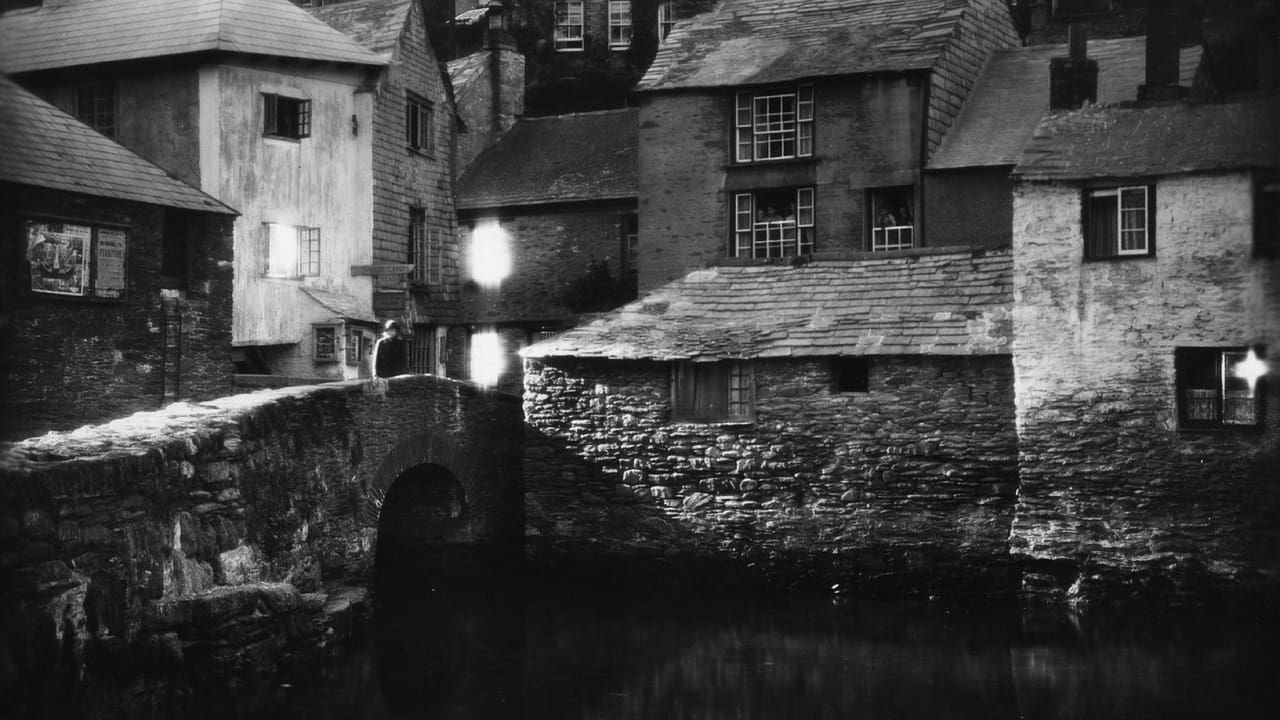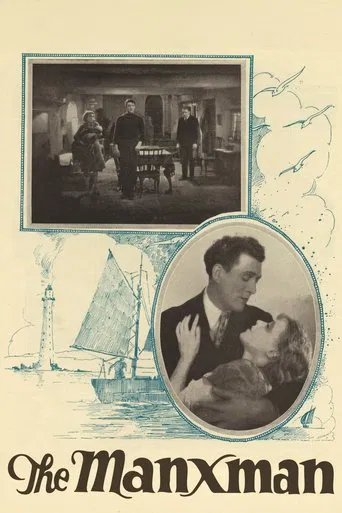

Some people may not realize that Alfred Hitchcock, master of suspense, got his start by directing silent pictures in England. The Maxman was his last non-talkie. And, like most of the Master's silent films, it's decent but not as clever as his later movies. It's a love triangle movie, really, which puts it firmly in the realm of the melodrama and pretty far from scares and chills.Pete (Carl Brisson) is a down-on-his-luck fisherman. He may not pull down a great paycheck, but he does have Kate (Anny Ondra), the beautiful daughter of Pete's landlord, Caesar (Randle Ayrton). Pete and Kate seem to really be into each other, and Pete plans to ask for her hand in marriage by way of her father, whose approval is mandatory. But he can't quite bring himself to ask the old man himself, so he asks his best friend Philip (Malcolm Keen), a lawyer, to speak for him. But Caesar will have none of it, seeking a man of actual means for his daughter, and he kicks Pete out. But that's okay, because Pete plans to sail to "foreign parts" and seek his fortune, and then they'll all be sorry! Pete asks Philip to look after Kate while he's gone, and Philip obliges. But soon he and Kate are falling madly in love with each other, which may complicate things when Pete returns. Suddenly - no spoiler! - news arrives that Pete has died while at sea. Now what do Kate and Philip do? They've kept the nature of their relationship a secret so far, but are they now free to bring it out into the open? In addition, Philip is a fast-rising barrister there on the Isle of Man, and he is line to be named the new Deemster (chief judge on the island). Will the revelation derail his career? This is one of those silent films that demands attention really be paid. There are some title cards, but there will be plenty of times when the viewer must make a reasonable inference of the dialog. There are, in fact, two scenes in which someone mouths something that isn't noted at all in a title card - and each instance is quite important to the plot. One must deduce their nature by checking the reaction of the other characters in the scene.The Manxman (i.e., man from the Isle of Man) does feature three fine performances and is a solid representation of films of the era. There are some plot twists, although modern viewers may be able to spot them well before they make their appearance in this movie.
... View MoreThe great film critic Roger Ebert coined the phrase "the idiot plot" in connection with movies that depend on idiotic behavior by their main characters in order to work at all. Here's proof of the concept in action long before Ebert came along to christen it.Bosom buddies Pete (Carl Brisson) and Philip (Malcolm Keen) follow different career paths on the Isle of Man; Pete fishes and Philip practices law. Pete falls in love with the barkeeper's daughter, pretty Kate (Anny Ondra) and asks Philip to look after her while he goes off to make his fortune. Philip looks after her alright, enough to be worried at news of Pete's return.The idiot plot, in this instance, is the fact that Pete and Kate aren't exactly lovers even before he leaves; director Alfred Hitchcock clues us in early to the fact Kate wants Philip and vice versa. Why then the hang-up about her pairing off with Philip? Philip himself says something about Pete's "faith in our loyalty," but it seems a thin idea to build a story around.An idiot plot alone isn't enough to condemn a film; looked at rationally it could be said "The Searchers" and Hitchcock's own "Vertigo" have them, too, and I think they're swell anyway. Here, however, the idiot plot is in service of a slow-moving film rife with unintentional comedy and two performances (Keen's and Ondra's) which are cringingly bad. You can't help noticing the characters acting stupidly when there's nothing much of quality to distract you.The only arresting element to this whole film, other than the fact it represents Hitchcock's final silent feature (he made some good ones, but really needed sound to find himself), is the cinematography by Jack E. Cox, which calls attention to itself from the opening shot of fishing boats sailing into port amid a strikingly craggy shoreline. Each outdoor shot grants you a new perspective at this offbeat location from this distant time.Whenever this film is inside, it is a real tooth-pull. Hitchcock favors long shots of the actors staring into the camera, eyes darting back and forth to indicate hidden secrets. Kate flounces about in a state of perpetual minxhood, seemingly unable to control her desire for Phil even if it means abandoning her baby to set up residency in Phil's closet. Phil could have been interesting if he was played as a bit of a louse, but instead Keen gives us a series of pained looks to indicate how aggrieved he is by the whole thing. He looks instead like a used-car salesman.There's a funny moment where Phil and Kate first get it on inside a mill, in which the camera decorously cuts to a grinding millstone after they embrace. Hello, train tunnel. But it gets rather ridiculous when Kate and Pete hold their reception in the same room, and Kate's Bible- thumping Dad somehow decides to use that same grindstone as an object lesson against backsliding and adultery."The mills of God grind slowly..." he warns, as Kate and Phil shrink in fear.The mills of Hitch grind slowly indeed in this film, all because Phil is too much of an idiot to tell his buddy the truth. If you want to see a solid example of Hitchcock before he really found himself, give this a look; if you want classic silent entertainment, look elsewhere.
... View MoreThis silent film is a drama. No frills. You could perform this on a stage with minimal props.Hitchcock takes this simple story, and performs "cinema" with it.I am not one who easily watches drama. I fidget and yawn. Hitch must have known that many people do this. He uses the camera in a masterful fashion.There are five characters listed as main characters, but actually only four are featured much-the romantic triangle and the girl's father.At first, we're led to think the best friend is diabolical, and in later films, he would be depicted that way. Here, however, he is a very three dimensional character, in love with his best friend's girl.We get very good imagery, very good backdrops, and very good camera work to tell a basic story. It moves briskly, and you won't be looking at your watch.This is not only exceptionally good drama, but exceptionally good cinema. A combination of reality and magic.
... View MoreThe "Manxman" in the title refers to a person from the Isle of Man--an independent part of the British Crown but technically not part of the United Kingdom. This large island is located between Britain and Ireland and actually produces its own money and has its own particular language (though English is commonly spoken). Outside the UK, I doubt if that man people are familiar with this place or would recognize the three-legged symbol (the "triskelion") on its flag. Just a bit of history to put the whole thing in perspective. Plus, it's the only film I can recall having seen that's set on this island.The film begins with two friends living on the island. Pete is a poor fisherman and Philip is from a well to do family. They both are in love with the same girl, though because Philip is such a nice guy, he stands aside and says nothing. However, the girl's father won't have Pete for a son-in-law because he's so poor, so Philip goes off to sea to earn his fortune. Unfortunately, word soon comes to everything that Pete has died, so Philip announces to the girl that he loves her. Coincidentally, it turns out she always loved Philip as well, so they plan on marrying. Then, out of the blue, Pete returns--he didn't die while at sea after all. The first thing he does is ask the girl again to be his bride. Heartbroken but feeling responsible since Pete asked her first, she agrees. Unfortunately, unknown to her and Philip is that she is carrying Philip's baby!! Yikes.Well, after the baby is born, apparently Pete couldn't figure out that the kid was his and Philip moves to England to start life anew. However, soon she follows him--leaving poor Pete stuck at home with the kid. What a mess, but in spite of this Pete keeps up a brave face and tells everyone she's on holiday. Later, he comes to see Philip to ask him to help find his wife--little did he know that she was with his best friend all along.If you think about it, this plot is very much like a soap opera and is nothing like the films for which Hitchcock became well-known. As far as the film goes, it is pretty interesting but the plot suffers from one problem. When Pete returned from sea, had they just told him the truth--that they fell in love AFTER they heard he was dead--then the whole mess could have been avoided. Sure, Pete would have been upset but would have no doubt understood. However, aside from this obvious solution, it's a pretty interesting film and is well made, though a tad predictable. As far as the acting goes, it's pretty good for a silent--without an serious over-emoting.By the way, Hitchcock's next film (also 1929) turned out to be Britain's first sound film. While this was well behind the US move to sound, it was still early compared to the rest of the world.
... View More